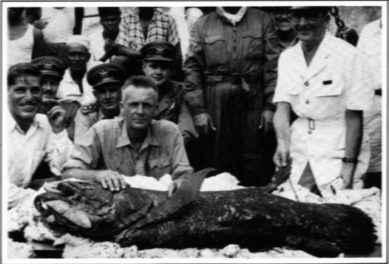HISTORY
On the 22 December, 1938, a fish was netted by fishermen of the Irving and Johnson vessle, Nerine, trawling off the mouth of the Chalumna river on the southeast coast of South Africa. The fish was about 1.5 m (5 ft) long, weighed 57 kg (126 lb), and was covered with deep-blue scales. A young curator of the East London Museum, Marjorie Courtenay-Latimer, as was her usual practise, inspected the catch at the wharf with the permission of Captain Hedrick Goosen, and came across this unusual fish which she kept as a specimen for the museum. She could not identify this fish and wrote a letter, including a rough sketch of the fish, and sent it to Prof. J.L.B. Smith at Rhodes University, Grahamstown, South Africa.The announcement that a Coelacanth had been caught off the Chalumna River mouth was made on 20 February, 1939.
And so began the amazing and wonderful story of the Coelacanth, considered to be the zoological find of the 20th century and an event that was heralded with banner reports world wide. To date, approximately 200 fish have been caught in and around the Comoros Archipelago.
The second Coelacanth known to science was caught off the Comoran island of Anjouan on the 20 December 1952. This concluded what Prof. J.L.B. Smith had suspected, these waters were the natural habitat of the Coelacanth. The fish was transported across the island and given to Capt.Eric Hunt who salted the fish to preserve it and set sail on his vessel, “Nduwaro” for Mayotte Island. Hunt arrived at Dzaoudzi, Pamanzi, a small Mayotte islet, early morning of the 22 December. The fish was injected with formalin and Hunt telegraghed J.L.B. Smith on the 22 December 1952. Further telegraphs were sent urging Smith to act without delay in order to secure his fish as the French authorities were trying to claim it. Smith and his wife were returning home from an East African expidition on the Dunnotar Castle and when the ship reached Durban on the 24th December, Smith received the cable from Hunt. Because it being Christmas Eve, there were no commercial flights. Smith finally managed to contact the Prime Minister, Dr.D.F.Malan, who also was on vacation at the time, on the 26th December. Permission was granted to use a military aircraft and the Dakota 6832 departed Pretoria on the 28th December, reached Pamanzi on the 29th, returned to Durban that same evening, Grahamstown on the 30th and returned to Pretoria on the 31 December 1952.
(This is the only aircraft ever to have flown 3000 miles to collect a dead fish)

This postcard was issued by the J.L.B.Smith Institute of Ichthyology. The postcard, taken from the origional photograph, portrays J.L.B. Smith, Capt. E.Hunt, the Dakota crew and the Governor of the Comores a few moments after the critical identification as a Coelacanth, on Hunt’s vessel at Pamanzi, Comores, 29 December 1952.
From left, Capt. Hunt, Lt. D.M. Raiston ( Senior Navigator), Capt. P. Letley, Prof. J.L.B. Smith, Lt. W.J. Berg, Comd. J.P.D. Blaauw (Commander - head out of picture on postcard), Cpl. F. Brink, Monsieur P. Coudet.
Cpl. J.W.J. van Niekerk is not in the photo.